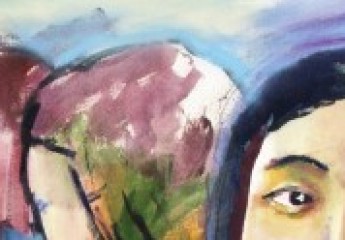watercolor of a house in Sicily by Prof. Rusty Nelson
A New Twist on a Longstanding Course Offering Provides Students with New Options!!
One of the Art Department’s longtime offerings for the Fine Arts Aesthetic Mode of Inquiry – Introduction to the Visual Arts (ART 203) – is going through a revision, and new course options will be offered for the first time during the Spring 2010 Semester. These courses will continue to meet the University’s Liberal Studies Program (LSP) requirements and due to changes in policy, will now be available to Art Majors in meeting an LSP requirement. The new course offerings will allow students to explore more focused topics and also to engage in studio practice to better understand the artistic process.
The first new option will allow students to explore art through the examination of specific topics through areas of focus such as: Gender and Art, The Landscape in Art, Environmental Art, Images of War, Politics in Art, Popular Art and the Modernist Tradition, etc. The second option will have a studio component that will not only allow students to learn about the material and aesthetic history of an artistic medium, but also gain firsthand insight into the creative process.
This second option further aligns the Art offerings for the LSP with other similar requirements. With few exceptions the Modes of Inquiry courses at Truman ask students to engage in disciplinary activities rather than just “study the practice or history of the discipline.” In other words, students in the Mathematical Mode “do” math, and in the Scientific Modes classes they “do” science by participating in laboratory activities. Our current Aesthetic Modes offerings do an excellent job of engaging students in art historical and aesthetic “practice,” but not in the creative process. By offering students the chance to engage in studio practice, the Art Faculty believes that students might develop an even greater understanding of the creative process.
Pilot offerings for these new options will include a course in drawing and another in watercolor. Beginning with the Spring 2010 Semester all art courses that meet the Aesthetic Mode of Inquiry for the LSP will be open to majors as well as non-majors. This new policy will give art students the chance to explore topics, issues, and media that they might not otherwise have available to them.
Course descriptions for the two Spring Semester offerings are included below:
ART 203 Introduction to the Visual Arts: Watercolor
Course Description: This course is about how watercolor can be used in the making of art based on an understanding of how it has been, and is currently, used.
As a means of visual expression, artists have used watercolor for over 3000 years. The medium’s current artistic use has an historical lineage in the development of materials and processes that dates back over 500 years in Europe and America. Up until the late 18th Century, watercolor was not considered a medium suitable for “finished” works. It was during this time period that artists, especially several key figures in England, began to see the potential of the medium as a primary means of expression. Students will examine both the historical development of the medium and the aesthetic issues related to its use by engaging in research, discussions and lectures coupled with actual studio practice in the medium. As students learn about artists who have used watercolor by examining the art historical context of their work, they will simultaneously engage in the use of the medium in a studio setting. Students will learn basic two-dimensional design elements and principles while having the opportunity to put this studio-based knowledge into practice.
Although this course focuses on watercolor and the requisite knowledge of its history and use, it is also intended to provide a foundation of knowledge that should allow students to better understand other art forms and media from art historical, aesthetic and material perspectives.
For more information on this course, please contact Prof. Garry Gordon at garry@truman.edu. The course will be offered Tuesdays & Thursdays 9:00 – 10:20 a.m.
ART 203 Introduction to the Visual Arts: Drawing
Course Description: This course meets the Fine Arts Aesthetic Mode of Inquiry through the study of the history of drawing as it relates to art and through active participation in drawing studio experiences.
It has been said that drawing has its roots in the very beginnings of human consciousness. The purpose and form of drawing, primarily due to its relation to art and artists in various societies, has changed over many centuries. During the Renaissance in Europe in the Fifteenth and Sixteenth Centuries, drawing played a vital role as a preparatory medium to art making. The increased use of oil painting in the Seventeenth Century saw drawing’s role become less a preparatory medium and more of an artist’s creative investigation (i.e. Rembrandt). Again, in the late Nineteenth and Twentieth Centuries, drawing was given a new life (role) in both Europe and America. As a result, drawing began to break down divisions between drawing, painting, and sculpture. It was during this time that drawing came to be viewed and displayed as an art form in and of itself.
Students will study the historical development of the role of drawing and how the character of drawing is constantly being redefined by engaging in research, discussions and lectures coupled with actual studio practice.
For more information on this course, please contact Prof. Bob Jones at bobjones@truman.edu. This course will be offered Mondays, Wednesdays, and Fridays 2:30 – 3:20 p.m.
